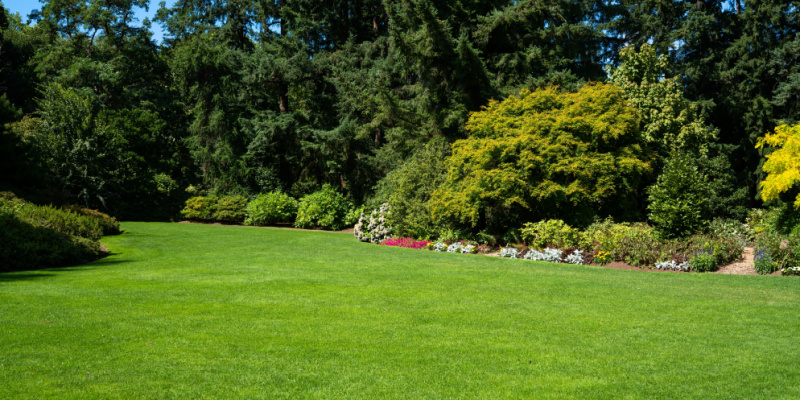Maintaining a flourishing lawn in Pickerington, Ohio, requires more than just regular watering and mowing. Lawns in the area are susceptible to various diseases that can cause unsightly brown patches, thinning grass, and an overall decline in turf quality. To preserve the beauty and health of your lawn, you should understand common lawn diseases in Pickerington and implement effective disease control and treatment measures. This article will explain key disease control strategies and treatment options available for lawns in Pickerington, OH.
1. Identifying Common Lawn Diseases in Pickerington
Before implementing disease control measures, it is important to be able to identify common lawn diseases in Pickerington. Some of the most prevalent diseases in the area include:
Brown Patch: Brown patch affects lawns in humid and hot regions. The disease typically appears as large brown patches on the lawn, ranging from a few inches to several feet in diameter. These patches can be round or irregularly shaped and may have a yellowish halo surrounding them. The fungus responsible for Brown Patch thrives on warm temperatures and high humidity levels, making it prevalent during summer. Lawns with poor drainage or overwatering are also more susceptible to Brown Patch infestations since the fungus requires waterlogged soil to thrive.
Dollar Spot: Dollar Spot can cause widespread damage to your turf. This infection targets the leaves of grass blades, causing them to turn yellow or brown and wither away. It looks like as small, circular patches about the size of a silver dollar coin, hence its name. The fungus responsible for Dollar Spot thrives in warm, humid conditions and can be spread through mowing equipment or foot traffic. It can also survive in the soil for months, making it difficult to eradicate.
Rust: Rust is a fungal disease that causes the grass to develop orange or rust-colored powder-like spores on the leaves. It is more prevalent in lawns with poor air circulation and low nitrogen levels.
2. Implementing Disease Prevention Practices
Prevention is key to reducing the risk of lawn diseases in Pickerington. Implement the following practices to create an environment that is less favorable for disease development:
Proper Mowing: A properly mowed lawn is not only visually appealing, but it also plays an essential role in promoting the health and well-being of the grass. Firstly, proper mowing helps to maintain consistent growth patterns by encouraging new root development. Cutting your grass at the right height stimulates growth from the roots up, resulting in fuller coverage across your lawn. Secondly, regular cutting ensures that you remove only a small percentage of each blade at any given time, encouraging healthier regrowth while reducing stress on the grass plants.
Adequate Watering: Lawn grasses require water to grow, photosynthesize, and stay green, especially during the hot summer. Adequate watering helps to cool down the surface temperature of your lawn, which in turn keeps the soil moist, promoting good root growth. It also prevents soil compaction and reduces weed growth. Watering your lawn deeply and infrequently can absorb nutrients from fertilizers more effectively than when it receives light, frequent watering. Regular irrigation promotes deep root growth through prolonged moisture penetration into the soil. Your lawn is also better equipped to withstand droughts with adequate watering as its roots are deeper, allowing them to hold moisture for extended periods.
Improve Air Circulation: Trim overhanging branches and thin out dense vegetation around your lawn to enhance air circulation. This reduces humidity levels and minimizes disease-friendly conditions.
Proper Thatch Management: Thatch, a layer of dead grass and organic matter, can create a favorable environment for disease development. Regular dethatching or core aeration helps prevent excessive thatch buildup.
Seed with Disease-Resistant Varieties: When overseeding or renovating your lawn, choose grass varieties resistant to common diseases in Pickerington. Disease-resistant grasses are less likely to be affected and can better withstand disease pressures.
3. Timely Disease Control Measures
Despite prevention efforts, disease outbreaks can still occur. Therefore, timely intervention is crucial to prevent further spread and minimize damage. Consider the following disease control measures:
Fungicide Application: When disease outbreaks are severe or persistent, fungicide applications may be necessary.
Proper Diagnosis: If you notice signs of disease in your lawn, it is essential to identify the specific disease accurately. Lawn care professionals can help with proper diagnosis, ensuring targeted treatment measures.
4. Seeking Professional Lawn Care Services
If you need help with disease identification or need assistance with disease control measures, it is advisable to seek professional lawn care services in Pickerington. Lawn care professionals have the expertise to diagnose and treat lawn diseases effectively. They can develop customized treatment plans based on the specific needs of your lawn, ensuring optimal disease control and recovery.
Disease control and treatment are essential for maintaining a healthy and vibrant lawn in Pickerington, OH. Remember that a well-maintained lawn, supported by proper practices and timely intervention, is more resistant to disease pressures. Invest in disease control measures by contacting Weed Busters to continually enjoy a lush and thriving lawn.

